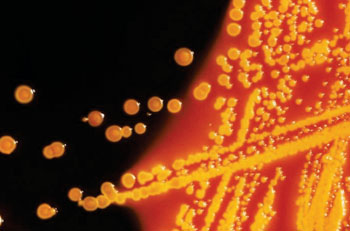Hijacked Commensal Gut Bacteria Promote Intestinal Foodborne Illnesses
By LabMedica International staff writers
Posted on 25 Dec 2014
Though many Escherichia coli bacteria are harmless and critical to gut health, some E. coli species are harmful and can be spread through contaminated food and water, causing diarrhea and other intestinal illnesses.Posted on 25 Dec 2014
The enteric pathogen enterohemorrhagic E. coli (EHEC) is the cause of severe diarrhea, but the influence of the gut microbiota on EHEC infection is largely unknown and a predominant member of the microbiota, Bacteroides thetaiotaomicron (Bt), is resident at EHEC attachment sites.

Image: Colonies of Escherichia coli bacteria grown on a Hektoen enteric agar plate medium (Photo courtesy of the CDC – US Centers of Disease Control and Prevention).
Microbiologists at the UT Southwestern Medical Center (Dallas, TX, USA) grew various strains of bacteria anaerobically and extracted ribonucleic acid (RNA) using a RiboPure Bacteria RNA isolation kit (Ambion; Grand Island, NY, USA). E. coli gene arrays were used to compare gene expression in strain EHEC O157:H7 strain 86-24 when cultured alone to that in strain 86-24 when grown in the presence of Bt. Growth curves and generation times were calculated. Quantitative reverse transcription-polymerase chain reaction (qRT-PCR) was performed in a one-step reaction using an ABI 7500 sequence detection system (Applied Biosystems; Foster City, CA, USA). Fluorescein actin staining assays and histopathology were also performed.
The team discovered that EHEC uses a common gut bacterium called B. thetaiotaomicron to worsen EHEC infection. B. thetaiotaomicron is a predominant species in the gut's microbiota, which consists of tens of trillions of microorganisms used to digest food, produce vitamins, and provide a barrier against harmful microorganisms. EHEC senses changes in sugar concentrations brought about by B. thetaiotaomicron and uses this information to turn on virulence genes that help the infection colonize the gut, thwart recognition and killing by the host immune system, and obtain enough nutrients to survive.
Vanessa Sperandio, PhD, Professor of Microbiology and Biochemistry, and senior author of study said, “We are testing the idea that differential gastrointestinal microbiota compositions play an important role in determining why, in an EHEC outbreak, some people only have mild diarrhea, others have bloody diarrhea and some progress to hemolytic uremic syndrome, even though all are infected with the same strain of the pathogen.” The study was published on December 10, 2014, in the journal Cell Host Microbe.
Related Links:
UT Southwestern Medical Center
Ambion
Applied Biosystems














